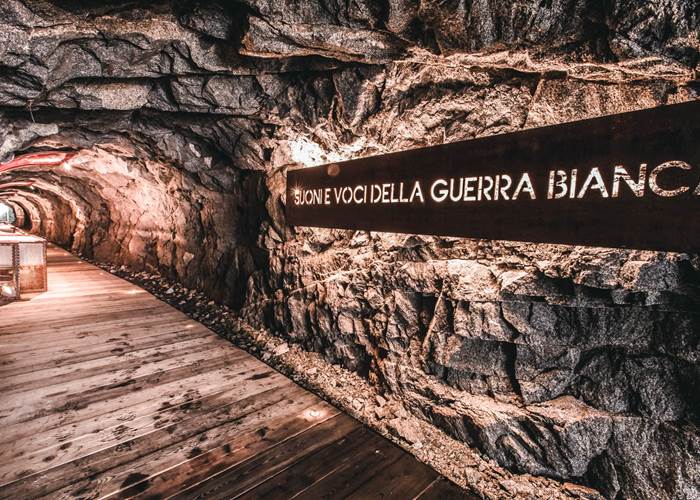On the paths of the Great War
In the Adamello-Brenta area you can visit many fortifications from the First World War that were erected in the mountains between Lombardy and Trentino. In Passo Tonale, the natural border between the Kingdom of Italy and Austria the so-called White War was fought, a mountain war with an extreme climate and the difficulties of an impervious territory.
Some fortifications from the Great War can still be visited and sometimes are home to museums and events of great historical interest. In addition they are connected by kilometres of paths that have been abandoned by soldiers but repopulated by history and mountain enthusiasts.
Below is a list of the main fortifications from the First World War in the Adamello area.
Forte Strino
Located on the road to Tonale before the bridge over Rio Strino, between the pass and the town of Vermiglio. Dating back to 1860 it was designed and built by the Austrians at the time when Trentino became the southern border of the Austro-Hungarian Empire. It was forgotten at the end of the First World War and renovated during the Nineties. Today it is part of the network of museums exhibiting war relics such as the camouflage uniform of Alpine skiers. Guided tours available inside.
Forte Zaccarana or Tonale
The highest fort at an altitude of 2,116 metres above sea level and the most avant-garde in the Tonale area during the Great War it was built at the beginning of the twentieth century with the most modern criteria for the construction of armed fortresses. The fort ensured full control of the surrounding valleys. The building can be reached on foot from Vermiglio by walking about 7 km on the old military road or from the path that starts from the Ospizio di San Bartolomeo, just above Passo Tonale. The building was secured in 2009 and some parts are open to visitors. From the fort there is a panoramic view over all of alta Val di Sole.
Forte Mero
This was the last fortification to be built in Tonale between 1911 and 1913. It was used for close defence and to control the area between Forte Zaccarana and Forte Presanella, that’s why it was not equipped with cannons but only with machine guns. On some of the walls there are still some remains of the colour used to camouflage it.
The fort was knocked down just 3 years after construction was completed by Italian artillery fire.
Even this one can be reached on foot from the Ospizio San Bartolomeo and in front of the fort there is an equipped parking area.
Forte Pozzi Alti or Presanella
The building was built between 1908 and 1912 in Val Vermiglio on the opposite side of Forte Zacarana. The fort was heavily damaged at the beginning of the war and subsequently demolished after the end of the war to recover iron and other materials. In 2008, thanks to funding from the Autonomous Province of Trento, work started to secure the ruins of the building. It can be reached on foot by walking for eight kilometres on the mule track that starts in Velon, a hamlet in Vermiglio.
Forte Velon
This small Austrian fort is located below Forte Strino and is connected to it by an armoured concrete staircase; its purpose was to ensure close defence of the fort above and control the valley floor at the same time. Currently it is not open to visitors, its ruins can be seen along the Statale del Tonale road after Vermiglio.
Forte di Corno d'Aola
The only Italian fort that protected the border, it was built in 13 years from 1900 to 1913 at an altitude of 1964 metres above sea level on the slopes of Mount Corno d’Aola, to the south of Ponte di Legno. The building was then blown up by retreating German soldiers at the end of the Second World War and today there are only a few ruins left near the ski resort of Valbione that can be reached by chairlift and by car.


